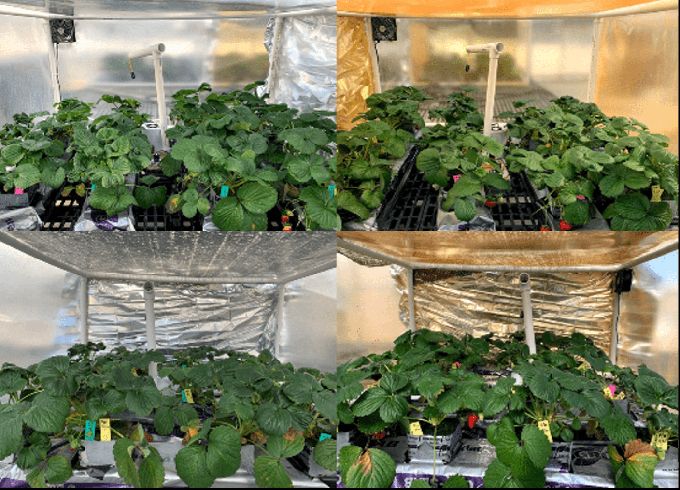In this study, the influence of spectral conversion under UbiGro quantum dot (QD) luminescent greenhouse films on plant growth and fruit yield of strawberries grown during winter was investigated.
 +14-28% Boost in Winter Strawberry Trial
+14-28% Boost in Winter Strawberry Trial

Case Study from | UbiGro
ABOUT THE PROJECT
LIGHT ENVIRONMENT
During the experiment period, the average daily light inegrals (DLIs) were consistent between control and treatment groups, measured at 6 and 4 mol/m2/s under ambient and 40% shaded conditions, respectively. These DLIs are considerably lower than would be available during peak months, and as such this study demonstrates the QD film’s performance over strawberries in low light levels (winter). For both higher and lower DLI treatments, the light spectrum was characterized under the QD film and the control film, presented in the figure below.

The QD luminescent film converts a portion of ultraviolet and blue into green and red light. The fractions of photosynthetically relevant wavebands are shown in the table below, along with the relative differences between the QD and control films for each DLI regime. Notably, % Blue is reduced by 12-15% and % Red is boosted by 4-5%, resulting in a reduction in B:R ratio of 16-19%. LED studies have shown that lower B:R ratios (as low as 0.05) have shown higher fresh and dry mass accumulation in strawberries . Far-red (FR) was also increased by 3% under the higher DLI. Recent studies have suggested that adding FR to a spectrum for strawberries is helpful in plant extension which improves light capture.
The phytochrome photoequilibrium (PPE) values were similar under both film types. The PSS metric is a direct indication of the ability of a given horticultural spectrum (whether natural, artificial or a combination) to manipulate the phytochrome isoforms, which exist in two states, Pr (red) and Pfr (far-red). This indicates that the QD film is not making a major impact on the R:FR ratio, which is also evident in the table below.

PLANT TRIAL RESULTS
Production, as measured by harvested fruit per area (kg/m2), was increased by +14% under ambient greenhouse light and +28% for 40% shaded greenhouse light. Analyzing the number, size, and weight of each fruit allowed the conclusion that this production increase was due to an increase in the average weight and size of each fruit. At lower DLI, the QD film increased average fresh fruit weight by 44% and the average fruit diameter by 18%. At higher DLI, the QD film increased average fruit fresh weight by 10% and the average fruit diameter by 8%, however these increases were not statistically significant.


In general, growth metrics were similar for strawberry plants grown under both films at each DLI. Plant growth was quantified in terms of leaf number, crown diameters, plant diameter, leaf size, relative chlorophyll concentrations (SPAD index), and shoot fresh and dry weight. In each DLI regime, all plant growth parameters were similar under both film treatments. Similarly, we observed that at each DLI level, strawberry plants flowered and had fruits at similar times and they produced similar number of fruits and similar total fruit fresh weight per plant. These metrics are summarized in the table below.

IN CONCLUSION
These results suggests that sunlight spectral conversion using a QD luminescent greenhouse film, resulting in an increase in R:B ratio compared to a control film, can improve greenhouse strawberry fruit production; the effect is more extreme under lower DLI conditions. The mechanism for this production increase appears to be larger and heavier fruits, not an increase in fruit number. This indicates that under the QD film spectrum, the plants put more energy into fruiting biomass compared to vegetative biomass. This low-light level, winter study on strawberry production indicates that UbiGro could be beneficial for strawberries in northern climates or during winter or low light conditions. While this was a small trial, the promising results beg future work on larger trials.
Acknowledgement
The authors thank Lassen Canyon Nursery for strawberry plant materials.
The Daily Light Integral (DLI) is the amount of photosynthetic light received in one square meter each day. The average DLI is a measure of the quantity of light received by a plant over a given duration. Naznin, M.T., Lefsrud, M., Gravel, V. and Hao, X. (2016). Using different ratios of red and blue LEDs to improve the growth of strawberry plants. Acta Hortic. 1134, 125-130
https://www.lighting.philips.com/main/cases/cases/horticulture/strawberry-grower-alain-lutz
Sager, J.C., Smith, W.O., Edwards, J.L., Cyr, L.L. 1988. Trans. Am. Soc. Agric. Eng. 31:1882–1889.
The content & opinions in this article are the author’s and do not necessarily represent the views of AgriTechTomorrow
Comments (0)
This post does not have any comments. Be the first to leave a comment below.
Featured Product

